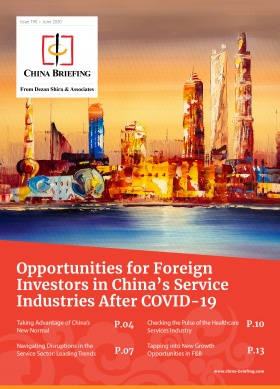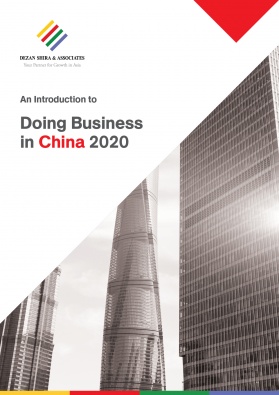How China’s Draft 2020 Encouraged Catalogue Improves Foreign Investor Access
On July 31, 2020, China’s National Development and Reform Commission (NDRC) and the Ministry of Commerce (MOFCOM) rolled out the exposure draft of the 2020 edition of the Catalogue of Encouraged Industries for Foreign Investment (“FI encouraged catalogue”) to seek public opinion until August 30, 2020 (full list in Chinese available here).
The catalogue, including two lists – one for the whole country and the other one for the central, western, and northeastern regions – identifies industries where foreign direct investment (FDI) will be welcome and treated with favorable policies.
Compared with the 2019 edition, the proposed 2020 FI encouraged catalogue has been further lengthened, with 125 new industries added and 76 previously listed industries amended.
The national list, which now contains 471 encouraged industries, has added 56 encouraged items and adjusted 40 items. The list for central, western, and northeastern regions has added 69 items and modified 36.
Where does the new draft catalogue stand on foreign investor access?
Similar to last year, the draft catalogue calls for more FDI in the following three main areas in China:
- High-end manufacturing;
- Production-oriented service industries; and
- China’s central, western, and northeastern provinces.
High-end manufacturing
The catalogue further encourages foreign-invested enterprises (FIEs) to participate in the high-tech development of its manufacturing industry.
The proposed national list has included or expanded items like manufacturing of certain raw materials, certain components and parts, and end products – with a focus on the automobile, computer, communications, and electronics industries.
For example, in terms of automobile manufacturing, the national list is keen to add the manufacturing of LiDAR (light detection and ranging) and millimeter-wave (MMW) radars related to autonomous driving technology as well as manufacturing of charging piles. In the fields of computer, communication, and electronics manufacturing, the proposed list added manufacturing of smart wearable devices, intelligent unmanned aerial vehicles (UAVs), customer service robots, and smart home systems and equipment.
Production-oriented service industries
The FI encouraged catalogue also promotes foreign investment in producer services.
The draft 2020 national list has added or expanded items like research and development, commercial services, modern logistics services, and information services.
For instance, in the areas of leasing and commercial services, the national list has added the maintenance and repair of modern high-end equipment, transformation and integration of digital production lines, and items about convention and exhibition services. It has also added non-academic language training institutions to the education section.
Investing in the central, western, and northeastern provinces
To narrow the economic gap between China’s wealthiest eastern coastal regions and the rest of the country, the third goal of this catalogue is to lure foreign-invested enterprises to increase investment in China’s less-developed central, western, and northeastern regions. Thus, the list for central, western, and northeastern regions has also been expanded, according to each province’s local conditions.
What are the preferential policies for encouraged industries?
So far, the following preferential treatment is still in place for FIEs engaging in the listed industries of the encouraged catalogue:
- Tariff exemptions on imported equipment – for encouraged foreign-invested projects, the import of self-use equipment within the total amount of investment can be exempted from customs duties;
- Access to preferential land prices and looser regulation of land uses – land can be preferentially supplied for encouraged foreign-funded projects with intensive land use. The land transfer reserve price can be determined at 70 percent of the national minimum price for the transfer of industrial land, which yet shall be no less than that of the local land; and
- Lowered corporate income tax (CIT) – for FIEs in encouraged industries in the central, western, and northeastern regions that meet the requirements, the CIT rate can be reduced by 15 percent.
Efforts to attract foreign businesses stepped up
Amid tensions with the US heating up on the economic, technological, and geopolitical fronts as well as the socio-economic challenges posed by the COVID-19 pandemic, Chinese policymakers are seeking to shore up supply chains and economic structural upgrades through investment at home and from abroad.
Early July, the NDRC and MOFCOM shortened the 2020 negative list, which restricts or prohibits foreign capital in certain industries, opening more market access for foreign investment.
Investors planning to engage in relevant areas are suggested to keep a close eye on the official announcement of the FI encouraged catalogue. For more information and local assistance in China, please contact us at china@dezshira.com.
About Us
China Briefing is written and produced by Dezan Shira & Associates. The practice assists foreign investors into China and has done so since 1992 through offices in Beijing, Tianjin, Dalian, Qingdao, Shanghai, Hangzhou, Ningbo, Suzhou, Guangzhou, Dongguan, Zhongshan, Shenzhen, and Hong Kong.
Please contact the firm for assistance in China at china@dezshira.com. We also maintain offices assisting foreign investors in Vietnam, Indonesia, Singapore, The Philippines, Malaysia, Thailand, United States, and Italy, in addition to our practices in India and Russia and our trade research facilities along the Belt & Road Initiative.
- Previous Article Come gestire il lavoro dei dipendenti stranieri e i permessi di residenza: Serie Divieti di Viaggio COVID-19 in Cina
- Next Article Antrag auf ein Sondervisum und Einreise nach China: 3 Fallstudien








